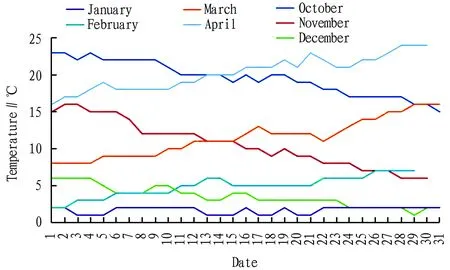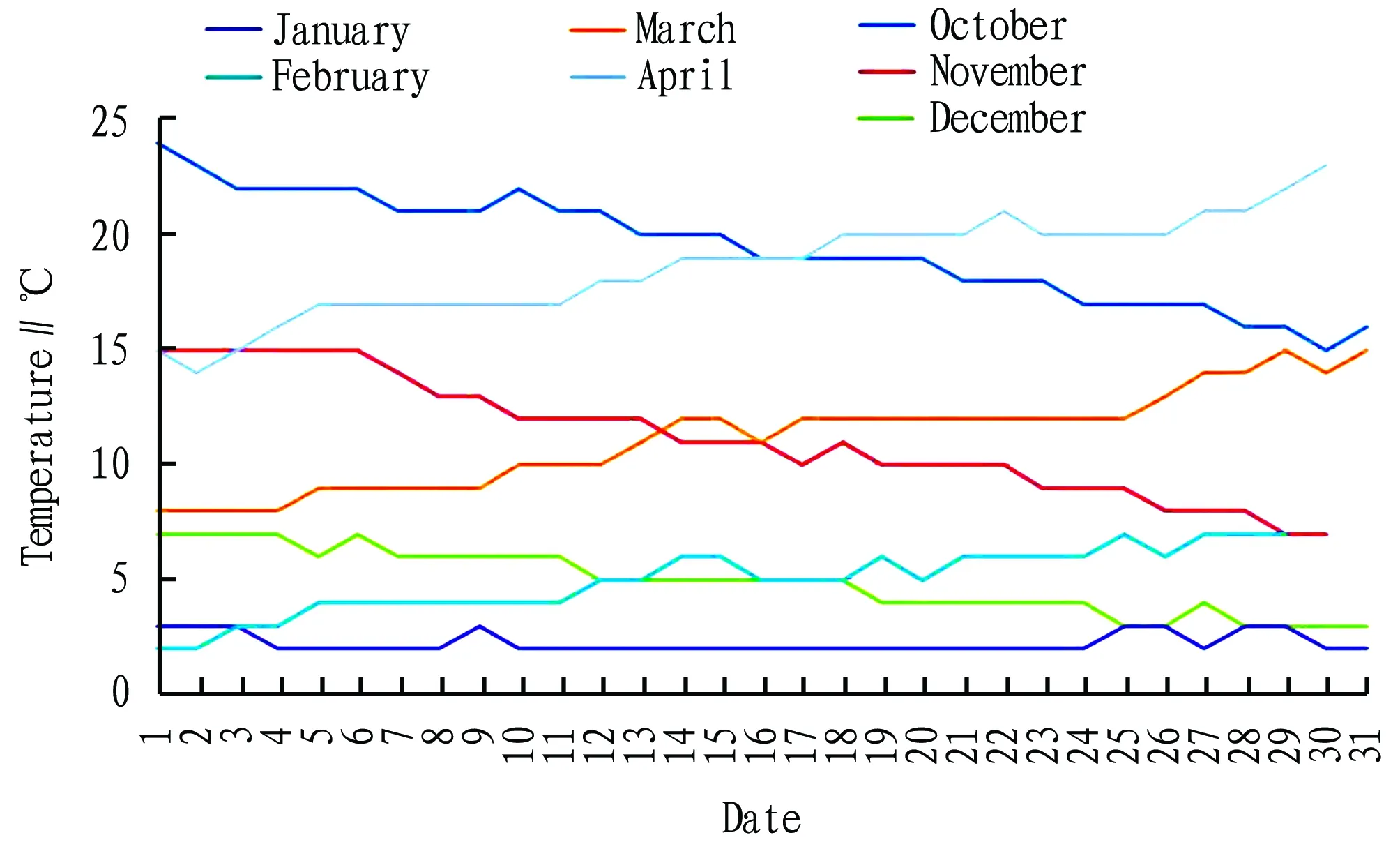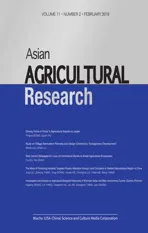Biological Characteristics of Morel and Analysis of Its Cultivation Adaptability in Tianjin
2019-03-20,*,U,,,,*
, *, U, , , , *
1. Tianjin Research Institution of Forestry and Pomology, Tianjin 300384, China; 2. National Engineering and Technology Research Center for Preservation of Agricultural Products (Tianjin), Tianjin 300384, China; 3. Tianjin Agricultural University, Tianjin 300384, China
Abstract Biological characteristics of morel, climatic conditions and characteristics of Tianjin, and facilities of greenhouses in Tianjin were introduced firstly, and then the cultivation adaptability of morel in Tianjin was analyzed. This study aims to let farmers learn more about the rare edible fungus——morel and provide relevant theoretical basis and feasibility reference for the promotion and application of morel cultivation in Tianjin.
Key words Morel, Biological characteristics, Cultivation adaptability
1 Introduction
Morel (Morchellaspp.), which belongs to the genusMorchellaof Ascomycota of fungi, is named for its sunk appearance being like a lamb belly[1-2]. Morel has been hailed as the finest food since ancient times. It is a high-protein and low-fat health food rich in essential amino acids, vitamins, minerals and polysaccharides. Gu Kefeietal. analyzed the nutrients of wild morel and boletus, and the results showed that the amino acid score, chemical score, essential amino acid index, biological value of morel was slightly higher than those of boletus. The overall score of boletus was close to the Food and Agriculture Organization of the United Nations (FAO) standard mode protein, while morel was slightly higher than the Food and Agriculture Organization of the United Nations/World Health Organization (FAO/WHO) standard mode protein and more close to egg protein[3]. Morel is considered as a delicious edible fungus being second only toTuberspp. in Europe[1].
The ascocarp of morel is crispy and delicious. Morel has the effect of benefiting the intestines and stomach, helping digestion, reducing phlegm and regulating vital energy, and refreshing oneself. Japanese scientists have found that the extract of morel contains tyrosinase inhibitor, which can effectively inhibit the formation of lipofuscin. Tyrosinase inhibitor can treat the common pigmented skin diseases such as freckles and chloasma, age spots,etc[4]. In addition, morel has a significant effect on eliminating anxiety and improving sleep quality.
Morel is another ascomycete that can be artificially cultivated in edible fungi, which indicates people’s further understanding and application of edible fungi. In China, the artificial cultivation technology of morel was firstly applied in 2012. Since then, the artificial cultivation area of morel has increased year by year. The area was about 200 ha in 2012 and around 300 ha in 2013. It increased rapidly to about 533 ha in 2014 and peaked in 2015 (up to 1 617 ha). It was slightly low in 2016, only 1 560 ha[5]. According to the relevant industry, the planting area of morel in China from 2017 to 2018 would surge to 4 667 ha.
At present, the artificial cultivation and market of morel in China are in the ascendant. The main planting areas spread from Sichuan and Chongqing to neighboring areas, and it is distributed in Sichuan, Chongqing, Hubei, Yunnan, Guizhou, Henan and other places. It has been successfully planted in Hebei, Shanxi, Gansu, Xinjiang, Guangdong, Hunan, Fujian, Jiangsu, Anhui, Shandong, Beijing, Liaoning, Jilin, Heilongjiang,etc[5]. However, there have been no successful cases of artificial cultivation in Tianjin. In this paper, biological characteristics of morel, climate characteristics of Tianjin and facilities of greenhouses in Tianjin will be introduced to analyze the feasibility of carrying out facility cultivation of morel in Tianjin.
2 Biological characteristics of morel
Wild morel is distributed all over the world. It grows at an altitude of 0-4 500 m, and fruits naturally from February to November. Artificially cultivated morel fruits from February to April. It fruits from April to July at high altitudes and in northern areas, such as Xinjiang, Qinghai, Gansu, Heilongjiang, Liaoning and other provinces. However, there are cases of early fruiting in northern areas.
Most species of the genusMorchellaare saprophytes, which are not selective for soil types, and will fruit on the edge of deserts, beaches, sandy land, arable soil and forest soil. Some species may form ectomycorrhiza with plants.
Morel is a low-temperature bacteria. The optimal temperature of mycelium is 22-25℃, and the growth rate can reach 10-20 mm/d on a general medium. When temperature is below 5℃, it grows slowly. The hyphae are sparse at above 35℃ and are more likely to die at above 40℃. The optimum temperature for the fruiting of the fruiting body is (15±3)℃. When temperature exceeds 8℃ for more than 3 d, it is easy to form the primordium of the fruiting body. As temperature is higher than 18℃, there is no primordium forming. When temperature exceeds 25℃, the fruiting bodies all fall down and die, and special attention should be paid to prevent high temperatures in the later stage of fruiting.
Morel likes a humid environment. The water content of culture material for mycelial growth is similar to the water content required by general edible fungi, and the optimum water content is 60%-65%. It should be not less than 55% and not higher than 70%. When the fruiting body appears, soil water content is 20%-23%, and air relative humidity is 85%-90%. When soil water content is low, the fruiting body is not easy to appear, and the formed fruit body is also prone to death. However, soil water content can not exceed 25%, otherwise the mycelium is prone to death due to oxygen deficiency.
The optimal pH for the growth of mycelium and fruiting body of morel is 6.5-7.5. The pH of culture material is over 8.0 and should not be lower than 5.0. Morel does not require light at the growth stage of hyphae. Like ordinary edible fungi, light inhibits the growth of mycelia. The primordium of the fruiting body needs to be stimulated by weak light when it is formed, and light intensity is 10-100 Lx.
Morel is aerobic. If it is aerated well, it grow fast. If it is aerated poorly, its aging is slow. When the fruiting body is formed, the demand for oxygen is strong, and CO2concentration is required to be no more than 0.3%.
3 Climate conditions and characteristics of Tianjin
The data of annual average maximum and minimum temperature in Tianjin on the internet (www.tianqi.com) were collected and analyzed (Fig.1 and Fig.2). It is initially judged that the optimal planting time of morel in Tianjin is from late October to next early April. During this period, Tianjin experiences autumn, winter and spring, and morel should be protected against wind, cold and high temperature. Therefore, it is suggested that morel should be planted in a greenhouse in Tianjin.

Fig.1AveragemaximumtemperatureinTianjinfromOctobertonextApril

Fig.2AverageminimumtemperatureinTianjinfromOctobertonextApril
4 Analysis of cultivation adaptability of morel in Tianjin
According to the biological characteristics of morel, it is judged that the optimal planting time of morel in Tianjin is from late October to next early April. In order to prevent special weather changes from causing large losses to the cultivation of morel, it is best to adopt facility cultivation. For instance, shade nets or quilts should be added to greenhouses, cold sheds,etc., or the assistance of small arch sheds and other simple facilities can be provided, which can meet the conditions for the growth of morel. Arch sheds should be adopted instead of flat sheds.
Before sowing, soil needs to be ploughed to remove stones and other debris. Most of the soil in Tianjin is alkaline. If the soil is acid, a small amount of quicklime can be applied to adjust the pH of the soil.
In solar greenhouses, facilities are relatively complete. And temperature is well controlled. When it is the coldest in winter, soil temperature is also above 0℃. In spring and autumn, the highest air temperature is 25℃, and it is windy. A shade net can be added outside a greenhouse, and the temperature inside the greenhouse should be controlled below 20℃. Meanwhile, the changes of humidity in the greenhouse and soil should be observed. If the humidity is high, the greenhouse should be ventilated to properly to decrease the humidity. If the humidity is low, soil moisture can be increased by watering in ditches between rows, and air humidity in the greenhouse can be moderately increased with an atomizer. Therefore, it is more suitable to plant morel in a greenhouse in Tianjin. By appropriately controlling temperature, humidity, light, CO2and other conditions, the adaptability of morel planted in Tianjin can be improved.
5 Conclusions
According to the above characteristics of morel and climate conditions and characteristics of Tianjin, morel is suitable for facility cultivation in Tianjin. However, several points need to be paid attention to.
First of all, morel is a new variety in the cultivation of edible fungi, and the cultivation of morel is in the experimental stage. For example, strains and management techniques are limited to the condition of regional relative maturity. Therefore, it can be
planted in an appropriate amount in Tianjin, and it is not allowed to cultivate it on a large scale to avoid causing large losses.
Secondly, cultivated strains must be carefully selected. The strains of edible and medicinal fungi are mostly obtained by tissue separation of fruiting body and spore separation, and most of them can fruit. However, morel is an exception, and many isolates often do not fruit in a large area.
Thirdly, morel is a low-temperature edible fungus. When it is planted in a facility greenhouse, it should be protected against direct sunlight and high temperature, and temperature inside the greenhouse should not exceed 25℃, which is the difference between morel and other edible fungi in terms of cultivation management.
Fourthly, in addition to strains, cultivation management technology is an important factor in the success cultivation of morel. Whether temperature, humidity, light, CO2and other conditions can be managed well determines its fruiting time, quality and yield.
In short, the road of artificial cultivation technology of morel needs to be explored for a long time, and relevant theories need further study. The author is conducting a cultivation test of morel in Xiqing, Wuqing, Jinghai and other areas in Tianjin. With the development of theory and practice, it is believed that the cultivation of morel in Tianjin will be successful soon to fill the gap in Tianjin.
杂志排行
Asian Agricultural Research的其它文章
- Driving Force of China’s Agricultural Exports to Japan
- Economic Value Evaluation of Fine Individual Plants ofRibesrubrum Linn.Based on AHP
- Profit Delivery Proportion,Operation Performance and Bond Rating of Agricultural State-owned Enterprises
- Design and Realization of Communication Platform"CDream Creating a Dream"for College Students
- Causes of Recurrence of RiceChilosuppressalis(Walker)in Longyou County and Prevention and Control Measures
- Landscape Space Creation of Red Star·Xintiandi Exhibition Area in Liuzhou
